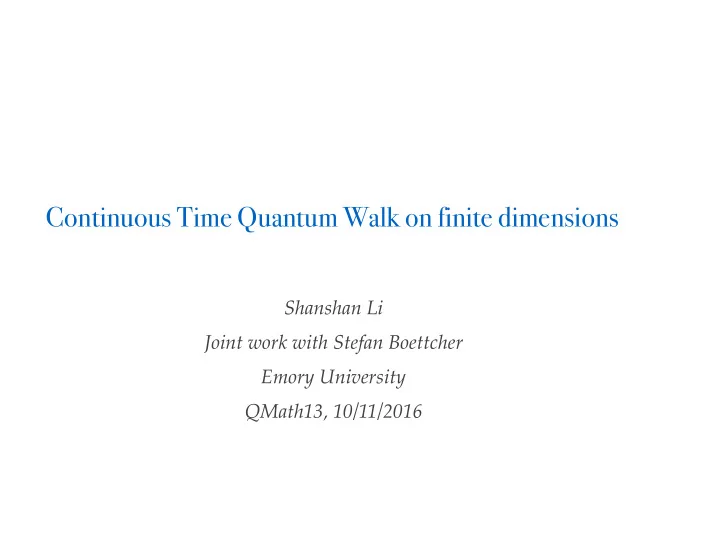

Continuous Time Quantum Walk on finite dimensions Shanshan Li Joint work with Stefan Boettcher Emory University QMath13, 10/11/2016
Grover Algorithm: Unstructured Search ! #$%&' $()*%$ Oracle f(x) ( 1 x = w f ( x ) = 0 otherwise Initialize the system to the state N − 1 1 X | s i = p | x i U s = 2 | s i h s | � I N x =0 U w = I � 2 | w i h w | Apply Grover Iteration N | s i √ 1 ( U s U w ) θ = 2 arcsin √ N
Quantum Walk Basics for Spatial Search Random Walk Unstructured search: N − 1 f(x) is a computable function d X dtp x = L xy p y Spatial Search: y =0 N items stored in a d-dimensional physical space Continuous time quantum walk d Ψ x ( t ) X = H xy Ψ y ( t ) dt y H = γ L � | ω i h ω | | s i = 1 X initial state | x i N x Laplacian = Degree Matrix - Adjacency Matrix marked state | w i L = D − A
Critical Point in the Hamiltonian γ = 0 γ = 1 H = � | w i h w | H = γ L 0 th , 1 st = | w i , | s i 0 th , 1 st = | s i , | w i γ = γ c p 0 th , 1 st = ( | w i ± | s i ) / 2 p T = π N 2 A. Childs et al. Spatial Search by Quantum Walk (2004)
CTQW: optimal performance Quadratic Speedup ⇣ √ ⌘ Grover efficiency O N • complete graph, hypercube, strongly regular graph (E. Farhi and S. Gutmann 1998, A. M. Childs et al 2002, J. Janmark et al, 2014) 3 2 N/N p ≥ log • Erdös Renyi graph ( SS. Chakraborty et al, 2016) d > 4 • lattices (A. M. Childs et al 2004) ❖ We extend CTQW to fractal graphs with real fractal dimension ❖ Spectral dimension of graph Laplacian determines the computational complexity
Finite Dimensional Fractals we generalize to arbitrary real (fractal) dimension ❖ Hierarchical networks ❖ Sierpinski Gasket, Migdal-Kadanoff network with regular degree 3 ❖ Diamond fractals b ased on the Migdal-Kadanoff renormalization group scheme
Dimensions in fractal networks Fractal dimensions 6 � i N ∼ l d f 5 N = 16384 1 4 � i 3 2 0.1 1 Spectral dimension 0 5000 10000 15000 N = 16 i 0.01 N = 32 N = 64 N = 128 N = 256 λ i ∼ N − 2 /d s 0.001 N = 512 N = 1024 N = 2048 N = 4096 0.0001 N = 8192 N = 16384 0.0001 0.001 0.01 0.1 1 i / N Hierarchical Network with regular degree 3
Migdal-Kadanoff renormalization group(MKRG) Model regular lattices closely arbitrary real dimension b Bond-moving scheme on square lattices with rescaling length l=2, branching factor b=2
Procedure to build the Diamond Fractals k=0 k=1 k=2
Measure Critical Point The spectral Zeta function When the CTQW is optimal for search, the critical point takes place (numerically true for almost all sites in fractals we consider) The transition probability A. Childs et al. Spatial Search by Quantum Walk (2004)
Assumption on fractal Laplacian eigenvector MK renormalization group with b=2 10 Highest Level 1 0.1 2 10 nd -Highest Level N |< w| � i >| 2 1 0.1 10 rd -Highest Level 3 1 0.1 1 10 100 1000 th eigenvector i
Renormalization Group Argument h L ( k ) ⇣ ⌘i h L ( k +1) ⇣ ⌘i q ( k ) , p ( k ) q ( k +1) , p ( k +1) det , · · · det , · · · i i i i The spectral Zeta function ✓ @ ◆ j 1 � ln ✏ det ( L + ✏ ) | ✏ → 0 I j ∼ @✏ ( 2 j ds − 1 d s < 2 j N ∼ d s > 2 j const
Computational Complexity of CTQW ❖ spectral dimension of network Laplacian determines the computational complexity ❖ complement the discussions on regular lattices and mean-field networks References: ❖ Shanshan Li and Stefan Boettcher, arXiv preprint arXiv: 1607.05317 , 2016 ❖ Stefan Boettcher and Shanshan Li, arXiv preprint arXiv: 1607.05168 , 2016
Thank you !
RG calculation for spectral determinant b • Stefan Boettcher and Shanshan Li, arXiv preprint arXiv: 1607.05168 , 2016
Recommend
More recommend